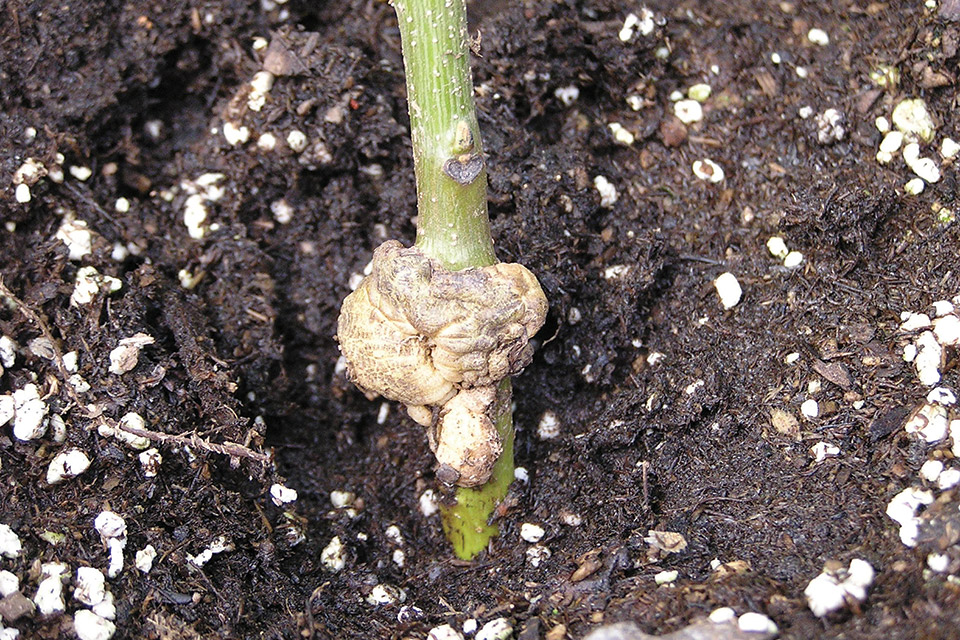New Walnut Rootstocks May Offer Disease Resistance

A walnut tree that Daniel Kluepfel and his USDA-ARS research team are inoculating with the crown gall pathogen to ultimately create crown gall-resistant walnut rootstocks. (Photo: Daniel Kluepfel)
The U.S. is the world’s largest exporter of English walnuts, topping more than $1 billion annually. However, diseases still cause an estimated 18% annual yield loss worth an estimated $241 million to the industry.
With such large losses, the walnut industry spends a lot of time examining production issues to help determine research priorities. Most English walnut production in the U.S. occurs in the Central Valley of California. A production research advisory committee (PRAC), including academics, growers, and other industry stakeholders, meets frequently to discuss the problems growers are seeing in the state, such as diseases that can ravage crops.
Daniel Kluepfel, Research Leader of the USDA-Agricultural Research Service (ARS) Crops Pathology and Genetics Research unit located at the University of California, Davis, is a member of PRAC and conveys the committee’s findings to his team of plant pathologists to drive their research focus.
“We look at what the industry is concerned about and that’s where we focus our research efforts,” Kluepfel says.
Diseases Affecting Walnuts
Commercially used walnut rootstocks in the California walnut industry are seriously affected by three soil-borne pests. These include nematodes, Phytophthora root and crown rot, and crown gall.
The most widespread disease is crown gall, which is caused by a soil-borne bacterium that lives in the soil and can distort healthy tissue into large tumors, or galls at the crown or on the roots of walnut trees.
“The plants don’t necessarily die within a year with all diseases,” Kluepfel says. “That’s what makes them more insidious.”
For example, crown gall makes plants less efficient, such as in water use, significantly reducing yield. It can also make trees more vulnerable to secondary infections, such as those from wood-rotting fungi, against which the tree would normally be able to defend itself. The grower is left to decide if it’s better to leave the tree or pull it out.
“This is a very hard, complicated decision for growers,” Kluepfel says.
Previously, growers could fumigate fields with methyl bromide or other compounds before planting. But such fumigants are now increasingly restricted, and other options like Telone (Corteva Agriscience) or chloropicrin are also coming under fire for environmental and health effects.
“Developing disease-resistant rootstocks can reduce or eliminate the need for these fumigants,” Kluepfel says.
Disease-Resistant Rootstocks
Kluepfel and his team are working to identify, characterize, and ultimately deploy crown gall disease-resistant walnut rootstocks.
His team has access to the USDA-ARS National Clonal Germplasm Repository. The collection includes Mediterranean-adapted crops such as pistachios, almonds, walnuts, and figs. Scientists have traveled the world to bring back seeds or cuttings.
“We go in to the germplasm collection and ask the question, ‘Which one of you are resistant to any of these diseases or bugs we’re looking at?’” Kluepfel says. “We set up screens in the greenhouse and in the field to basically try to kill them all off and only let the resistant types survive.”
Through these trials, they are able to map disease-resistant genes and provide that information to breeders who incorporate it into other plant varieties, or cultivars, that are useful for the industry.
Testing is Slow
Due to the nature of tree growth, testing walnut rootstocks is a slow process. Walnut trees take much more time to mature, even longer than almonds.
“They’re a bit of a pain in the neck,” Kluepfel says. “It’s definitely more challenging to screen rootstocks for walnuts than it would be for tomatoes, peppers, or sunflowers. We are limited in the numbers we can test because they are trees and take more time to grow and more space in
the greenhouse.”
Walnuts can’t be crossed with other stone fruit rootstocks — such as peaches or plums — as almonds can, but with at least 14 walnut species in the collection there’s still a nice selection. In fact, most commercially cultivated English walnuts are grafted onto the rootstocks of other varieties that are less susceptible to pathogens like crown gall.
Northern California black walnut became the rootstock of choice in the early 1900s due to its tolerance of waterlogged soils, but its Phytophthora susceptibility led the industry to explore the use of paradox hybrids. However, paradox seedling rootstock can also be susceptible to Phytophthora, nematodes, and crown gall disease, hence pushing the industry to continue exploring other options.
Kluepfel and his team had been doing so at a low level for a number of years, until about five years ago when USDA-NIFA-SCRI funding helped dramatically increase their efforts.
“We’re at the point where we have generated hybrids using a ‘mom’ and ‘dad’ that tend to produce offspring with higher levels of crown gall resistance,” Kluepfel says.”
One hopeful rootstock is Juglans microcarpa, or the Texas black walnut. In addition to its disease resistance, it’s also indigenous to the Southwestern U.S., so it’s adapted to arid climates. Such drought tolerance could be beneficial in California.
The research team has begun large field trials with the Texas black walnut/English walnut hybrid rootstocks with ‘Chandler’ English scions — the most popular variety of California walnuts — in addition to other potential candidates. This next step of testing will provide a more accurate idea of field performance.
If all goes well, Kluepfel expects one or two cultivars may be of interest to the industry. In addition to those, his team has several other promising varieties coming down the pipe that will eventually move onto field trials as well. But those trees will also take time to grow.
Kluepfel is confident that within the next four or five years, his team should have enough materials to interest the breeding industry to begin testing these recommended genotypes. Then breeders will conduct their own trials, which will also take some years.
“It can take another 10 years or more before growers feel confident enough to put a crop in the field that they hope will stay there for 30 years,” Kluepfel says.
Still, he said growers should know that researchers are aware of their problems and have come a long way in understanding how varieties tolerate disease.
“We’re moving as hard as we can to get these out for testing on a much larger scale,” he says.










